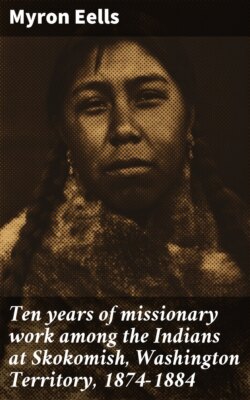Читать книгу Ten years of missionary work among the Indians at Skokomish, Washington Territory, 1874-1884 - Eells Myron - Страница 9
На сайте Литреса книга снята с продажи.
II.
PRELIMINARY HISTORY.
ОглавлениеTable of Contents
EVER since the Spanish traders and Vancouver in the latter part of the last century, and the Northwest Fur Company and Hudson’s Bay Company in the early part of the present century, came to Puget Sound, these Indians have had some intercourse with the whites, and learned some things about the white man’s ways, his Sabbath, his Bible, and his God. Fort Nisqually, one of the posts of the Hudson’s Bay Company, was situated about fifty miles from Skokomish, so that these Indians were comparatively near to it.
About 1850, Americans began to settle on Puget Sound. In 1853 Washington was set off from Oregon and organized into a territory, and in 1855 the treaty was made with these Indians. Governor I. I. Stevens and Colonel M. C. Simmons represented the government, and the three tribes of the Twanas, Chemakums, and S’klallams were the parties of the other part. The Chemakums were a small tribe, lived near where Port Townsend now is, and are now extinct. The S’klallams, or Clallams (as the name has since become), lived on the south side of the Straits of Fuca, from Port Townsend westward almost to Neah Bay, and were by far the largest and strongest tribe of the three. It was expected that all the tribes would be removed to the reservation. The government, however, was to furnish the means for doing so, but it was never done, and as the Clallams and Twanas were never on very friendly terms, there having been many murders between them in early days, the Clallams have not come voluntarily to it, but remain in different places in the region of their old homes. The reservation, about three miles square, also was too small for all of the tribes, it having been said that twenty-eight hundred Indians belonged to them when the treaty was made. There were certainly no more.
The treaty has been known as that of Point-No-Point, it having been made at that place, a few miles north of the mouth of Hood’s Canal on the main sound, in 1855. It was, however, four years later when it was ratified, and another year before the machinery was put in motion, so that government employees were sent to the reservation to teach the Indians. In the meantime the Yakama War took place, the most wide-spread Indian war which ever occurred on this north-west coast, it having begun almost simultaneously in Southern Oregon, Eastern Oregon, and Washington, and on Puget Sound. The Indians on the eastern side of the sound were engaged in it, but the Clallams and Twanas as tribes did not do so, and never have been engaged in any war with the whites. They were related by marriage with some of the tribes who were hostile, and a few individuals from one or both of these tribes went to the eastern side of the sound and joined the hostiles, but as tribes they remained peaceable.
